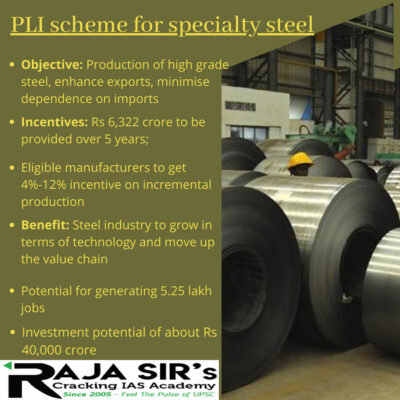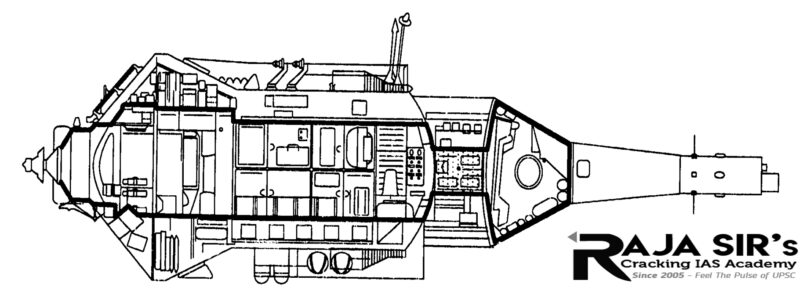- Home
- Prelims
- Mains
- Current Affairs
- Study Materials
- Test Series
 EDITORIALS & ARTICLES
EDITORIALS & ARTICLES
23rd July 2021
CABINET APPROVES PRODUCTION-LINKED INCENTIVE (PLI) SCHEME FOR SPECIALTY STEEL
Recently, the Union Cabinet has approved the Production Linked Incentive (PLI) Scheme for specialty steel.
What is Specialty Steel?


- It is value added steel wherein normal finished steel is worked upon by way of coating, plating, heat treatment, etc to convert it into high value added steel.
- It can be used in various strategic applications like Defence, Space, Power, apart from automobile sector, specialized capital goods etc.

- The duration of the scheme will be five years i.e. from 2023-24 to 2027-28.
- The five categories of specialty steel which have been chosen in the PLI Scheme are:
- Coated/Plated Steel Products
- High Strength/Wear resistant Steel
- Specialty Rails
- Alloy Steel Products and Steel wires
- Electrical Steel
- There are 3 slabs of PLI incentives, the lowest being 4 % and highest being 12% which has been provided for electrical steel (CRGO).
- Any company registered in India, engaged in manufacturing of the identified 'specialty steel' grades eligible to participate.
- It is expected to bring in investment of approximately ₹40,000 crores and capacity addition of 25 MT for specialty steel.
- It will give employment to about 525,000 people of which 68,000 will be direct employment.
- It is expected that the specialty steel production will become 42 million tonnes by the end of 2026-27.
- It will ensure that approximately 2.5 lakh crores worth of specialty steel will be produced and consumed in the country which would otherwise have been imported.
- The export of specialty steel will become around 5.5 million tonnes as against the current 1.7 million tonnes of specialty steel getting FOREX of Rs 33,000 crore.
- The specialty steel has been chosen as the target segment because out of the production of 102 million tonnes steel in India in 2020-21, only 18 million tonnes value added steel/specialty steel was produced in the country.
- Out of 6.7 million tonnes of imports in 2020-21, approx. 4 million tonnes import was of specialty steel alone resulting in FOREX outgo of Approx. Rs. 30,000 crores.
- India will move up the steel value chain and come at par with advanced steel making countries like Korea and Japan by becoming Aatmanirbhar in producing specialty steel.
- It will ensure that the basic steel used is ‘melted and poured’ within the country which means that raw material (finished steel) used for making specialty steel will be made in India only.
- The eight states are Andhra Pradesh, Chhattisgarh, Kerala, Himachal Pradesh, Jharkhand, Odisha, Madhya Pradesh and Tamil Nadu.
- It is a sub scheme of Paramparagat Krishi Vikas Yojana (PKVY).
- It was launched in 2020-21 for the promotion of traditional indigenous practices.
- It emphasizes on exclusion of all synthetic chemical inputs and promotes on-farm biomass recycling with major stress on:
- Biomass mulching;
- Use of cow dung-urine formulations;
- Plant-based preparations; and
- Time to time working of soil for aeration
- Under BPKP, financial assistance of Rs 12200/ha for 3 years is provided for cluster formation, capacity building and continuous handholding by trained personnel, certification and residue analysis.
- It is an elaborated component of Soil Health Management (SHM) of major project National Mission of Sustainable Agriculture (NMSA).
- It aims at development of sustainable models of organic farming through a mix of traditional wisdom and modern science to ensure long term soil fertility buildup, resource conservation and helps in climate change adaptation and mitigation.
- It primarily aims to increase soil fertility and thereby helps in production of healthy food through organic practices without the use of agro-chemicals.
- It aims at empowering farmers through institutional development through clusters approach not only in farm practice management, input production, quality assurance but also in value addition and direct marketing through innovative means.
- It promotes Participatory Guarantee System (PGS) For India (PGS- India) form of organic certification that is built on mutual trust.
- The Funding pattern under the scheme is in the ratio of 60:40 by the Central and State Governments respectively.
- In case of North Eastern and Himalayan States, Central Assistance is provided in the ratio of 90:10 (Centre: State) and for Union Territories, the assistance is 100%.
- To promote natural resource based integrated and climate resilient sustainable farming systems that ensure maintenance and increase of soil fertility, natural resource conservation, on-farm nutrient recycling and minimize dependence of farmers on external inputs;
- To reduce cost of agriculture to farmers through sustainable integrated organic farming systems thereby enhancing farmer's net income per unit of land;
- To sustainably produce chemical free and nutritious food for human consumption;
- To protect environment from hazardous inorganic chemicals by adoption of eco-friendly low cost traditional techniques and farmer friendly technologies;
- To empower farmers through their own institutional development in the form of clusters and group with capacity to manage production, processing, value addition and certification management; and
- To make farmers entrepreneurs through direct market linkages with local and national markets
- The International Space Station is currently operated by NASA astronauts Mark Vande Hei, Shane Kimbrough and Megan McArthur; Oleg Novitsky and Pyotr Dubrov of Russia’s Roscosmos space corporation; Japan Aerospace Exploration Agency astronaut Akihiko Hoshide and European Space Agency astronaut Thomas Pesquet.
- In 1998, Russia launched the station’s first module, Zarya, which was followed in 2000 by another big module, Zvezda, and three smaller modules in the following years. The last of them, Rassvet, arrived at the station in 2010.

- The navigational antennas and solar arrays deployed properly after a flawless launch that set the module on an eight-day journey to the orbiting outpost.
- After a series of maneuvers, the 20-metric-ton (22-ton) module is set to dock at the International Space Station in automatic mode on 29 July 2021.
- The launch of Nauka, also called the Multipurpose Laboratory Module, had been repeatedly delayed because of technical problems. It was initially scheduled to go up in 2007.
- In 2013, experts found contamination in its fuel system, resulting in a long and costly replacement. Other Nauka systems also underwent modernization or repairs.
- Before Nauka docks at the station, one of the older Russian modules, the Pirs spacewalking compartment, will need to be removed and scrapped to free up room for the new module.
- Russian space controllers plan to perform the maneuver after they check and confirm that Nauka’s systems operate properly and the module is ready for docking.
- Russian crewmembers on the station have done two spacewalks to connect cables in preparation for Nauka’s arrival.
- Once Nauka docks at the station, it will require a long series of manuevers, including up to 11 spacewalks beginning in early September, to prepare it for operation.
- Liverpool – Maritime Mercantile City was inscribed on the World Heritage List in 2004 and on the List of World Heritage in Danger in 2012 following concerns about the proposed development of Liverpool Waters.
- The project has since gone ahead along with other developments both inside the site and in its buffer zone.
- The Committee considers that these constructions are detrimental to the site’s authenticity and integrity.
- Liverpool’s historic centre and docklands were inscribed for bearing witness to the development of one of the world’s major trading centres in the 18th and 19th centuries.
- The site also illustrated pioneering developments in modern dock technology, transport systems and port management.
- Any deletion from the World Heritage List is a loss to the international community and to the internationally shared values and commitments under the World Heritage Convention.
- After the Elbe Valley in Dresden (Germany) and the Arabian Oryx Sanctuary (Oman), Liverpool is the third property to lose its World Heritage status.
- The International Council on Monuments and Sites, which advises UNESCO on the heritage list.









 Latest News
Latest News General Studies
General Studies